Source: CCTV.com
08-02-2006 16:47
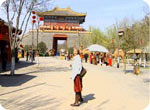
Located in Henan Province at the very heartland of China, Kaifeng is noted for having been the capitals of seven ancient dynasties. The city is loaded with ancient relics and folklores that can seem almost intimidating to first-time visitors. On the other hand, it is also a great interactive classroom for a dose of Chinese history.
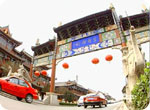
Songdu Yujie was the center of ancient Kaifeng city, and still the center of today’s Kaifeng city. Coz this city has remained at the same location for about 1200 years.
Today’s Dragon Pavilion, or Long ting, is the largest park in Kaifeng built on the ruins of ancient royal palaces.
You can get a crash course of Northern Song dynasty when all the 13 emperors of the period come out to greet visitors at the main entrance around 9 o’clock every morning.
Dragon Pavilion had been the imperial Palace for many dynasties in ancient China. Actually because of its excellent Fengshui, there had been altogether 22 emperors being enthroned here. From Dragon Pavilion, you can get a very good idea of the ancient Kaifeng city layout. For example, this used to be the axis of ancient Kaifeng city; of course, the original palaces of the Northern song Dynasty were already buried under the two lakes.
The two lakes have been given some historical significance like most places in the city. It goes that in the old days, the lake of family Yang was always clear and the lake of family Pan was always murky since family yang was known for their loyalty and family Pan was notorious for their treachery in Song Periods.
Legend apart, what we know for sure is that the severe flooding of Yellow River over the past millennium has brought thick layers of silt on top of the ancient palaces. As a matter of fact, the current Dragon Pavilion is sitting on top of at least two ancient palaces from different periods.
Religious services of such scale are held only couple times a year at the temple on festivals or special occasions.
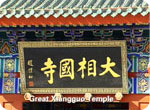
Great Xiangguo temple saw its heyday during Northern Song dynasty about 1000 years ago. It was the largest Buddhist temple in China at the time and served as the royal temple. Over the years, the temple was destroyed couple times due to warfare or natural disasters. Most of the architecture of the current temple was built in Qing Dynasty over 200 years ago.
I was almost spellbound gazing at the towering statue of the thousand-hand-and-eye bodhisattva, one of the treasures the temple takes pride in.
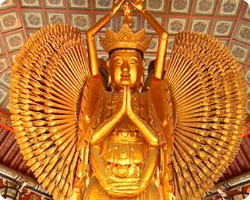
Standing at seven-meter-tall, the statue was carved out of a whole gingko tree trunk and consists of four figures looking exactly the same facing four directions.
Legend has it that it took the craftsman 57 years to finish the masterpiece. I am sure he found it worthwhile.
I’ve never had this kind of experience before, enjoying a concert in a monastery. I guess very different from Carnegie Hall at least.
Great Xiangguo temple was among the few temples in the country that carry a Buddhist band. It was the tradition of the temple though during its prime time centuries ago. The current band was formed in early 1990s and has become very popular when it comes to important Buddhist ceremonies all around the country.
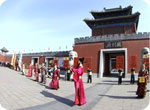
So this is the famous Kaifengfu, the prefecture of Kaifeng, sort of like the municipal government of the capital city about one thousand years ago. And looks like they are holding an opening ceremony to initiate today’s office hour.
Some may find it cheesy, but I think this kind of mini-shows is greatly informative to most travelers who are not so familiar with the history here. What you see here is how Lord Bao, the most respectable governor of Kaifeng Fu in Northern Song Dynasty, took care of a case against the royal family.
Looks like we’re gonna have an ancient Chinese version of people’s court or judge Judy today. And some guy is going to be in big trouble.
Lord Bao has sort of become the god of justice in imperial China for his uprightness and incorruptibility. During his term at Kaifengfu, he settled many unjust cases, which were widely depicted in dramas or folklores. He even had the courage to send convicted royal family members to guillotine, a heroic act almost unimaginable one thousand years ago.
Lord Bao held the post of Kaifengfu for only one year and four months. However, on the stone tablet that recorded the names of all the 183 officers of Kaifengfu in Northern song dynasty, Lord Bao’s name was almost unrecognizable since almost everybody would touch his name in awe.
There were a lot of such kind of neighborhoods in ancient Kaifeng city, but can you imagine about 900 years ago, there used to be a community, purely consisting of Jewish people living in one of these neighborhoods.
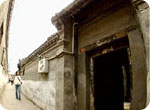
Journeying via probably the silk route from Persia, a small group of Jewish people, the exact number remains a focus of debate, settled in Kaifeng as early as the Northern Song dynasty. The Song emperor bestowed seven Chinese surnames to these Jewish families – Zhao, Zhang, Shi, Jin, Ai, Gao and Li. They were allowed to join the imperial exams and became government officials while holding onto Jewish customs and religion. However, after generations of intermarriage and a combination of many reasons, the tiny Jewish community lost touch with its roots and completely assimilated into the Chinese population.
Host: Smell good. Well, about eight hundred years ago, you might run into a family that was cooking kosher food here.
Kaifeng is one of a few historical metropolises in China that still preservers a significant amount of ancient city walls.
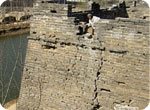
The city wall of Kaifeng has been rebuilt many times over the history, and this city wall you see here was rebuilt about 150 years ago. But can you imagine, beneath this layer of city wall, there were still two layers of different city walls under ground.
Host: Wow, from outside you can see the city wall is pretty high, at least ten meters tall.
If I lived in ancient Kaifeng city about 150 years ago, I should feel pretty safe, because the whole city was surrounded by this kind of city wall, see, protected by cannons. A lot of cannons holes, and all built with very solid stone bricks.
The stone bricks were glued together by a special material made of lime, glutinous rice paste, and tung oil.
Once probably a battlefield filled with the choking smell of cannon powder, the city wall now provides a perfect venue for local kids to seek out some romance in a spring day.
To finish off one day’s sightseeing, I highly recommend you going to a non-frill local teahouse and listening to Henan opera. This can definitely help you to understand the local culture better.
Compared to other area in China, I’d say that Henan people are really avid followers of their local opera. Almost on every street corner you can hear the loud and invigorating tunes.
After a full day of history and culture, a trade of gourmet food can surely make the memories last longer, right?
You can find at least couple hundred food stands on the gulou city square, and it is just one of the night markets in town!
Since there’s a relatively large Muslim population in Kaifeng, a lot of the foods stand here sell the Chinese Muslim style gourmet food.
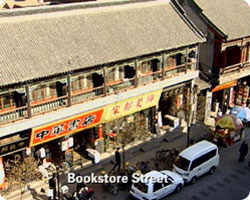
To the north of gulou square night market is Shudian Street, or Bookstore Street. True to its name, the 300-meter long street specializes in trading books, stationeries, papers, brush pen, and other study room-related items.
The street started to prosper in early 20th century when Qing dynasty held the last couple imperial exams in Kaifeng.
The architectures along the street are mainly of the late Qing style.
Zhuxian Zhen spring festival prints, or NianHua, date back to 1000 years ago and reached its prime time about 300 years ago.
Traditional people would put it on the front door before spring festival to pray for good fortune, happiness, and protection from harm.
The subjects of the prints are mostly based on gods or heroic characters from Buddhism, Taoism, Confucianism, and folklores.
I’m sure you will enjoy this part as much as I did--- getting some hands--- on experience.
In normally takes six to eight boards to print one copy as each board fills out a different color on the print.
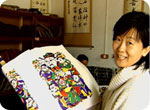
No wonder the color is so pretty. All five pigments were made from natural material. For example, yellow is from a special kind of flower, and purple, sunflower seeds! And one advantage of this pigment is that the color can last a long time.”
Although Zhuxian zhen NianHua was rejuvenated only in the past couple decades, it still boasts the most varieties among all the spring festival prints in China.
In Zhuxian zhen, you can find almost 100 different designs and over 300 wood boards. There are even antique boards from Ming dynasty 300 years ago.
NianHua is even getting more popular in overseas market as collection or decorating items.
Shan-shan-gan guildhall in downtown Kaifeng is a must-see for architectural buffs. Every building in the whole complex is decorated with dazzling woodcarvings. In addition to drawing from drama, folklores, or religious stories, some of the carvings here depict the daily life of ancient China, which is rare among the buildings from couple hundred years ago.
Altogether seven beams of all kinds of elaborate carvings and some carvings techniques were already lost.
The work is anything but Mimamlism. Images of auspicious intentions were formed with numerous animals, flowers, fruits and plants enter twining together or dangling down.
I’d say this kind of artwork is almost unimaginable given the hasty modern life pace.
The guildhall is now part of a temple to worship Guanyu, an ancient Chinese warrior who is known for his gallantry and loyalty. In good old times, (or of legendary Guanyu would be performed here.)
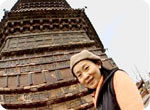
One of the symbolic views of Kaifeng city, iron pagoda, but it’s not made of iron, because it’s all covered with dark-colored glazed tiles, resembling the color of iron, so it’s called iron pagoda.
The pagoda was first built in the year of 1049 ad, and is one of a few relics in Kaifeng that had survived 900 years of warfare, flooding, and other natural disasters.
On the glazed tiles, there are around 50 different vivid carvings of Buddha sculptures.
The pagoda stands at 55 meters; it takes quite some climbing to get to the top.
HENAN UNIV
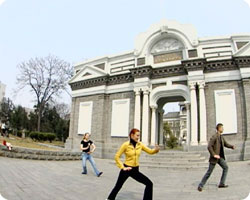
No longer a political, economic and culture center as it used to be back in Northern Song dynasty, Kaifeng still attracts overseas visitors for its rich history.
Ulia, a Russian student studying Chinese language at Henan University took me to a tour around her campus.
Founded in 1912, as the Preparatory School for Further Study in Europe and America, Henan University was one of the oldest universities in China and boasts impressive alumni in the contemporary Chinese history.
The history of some of the buildings on campus goes further back to 19th century since the university was built on the site of the Henan Park, the place for imperial exam in Qing dynasty.
Now time to have some silly fun after much history and culture talking, right? Let’s go check out what the streets of Kaifeng a thousand years ago had to offer.
A huge theme park literally based on the painting scroll of Qingming on the River has been built right next to the Dragon Pavilion.
One day in the park, a thousand years over the history – may seems exaggerating of the park, but ever so true of Kaifeng City.
Editor:Chen

